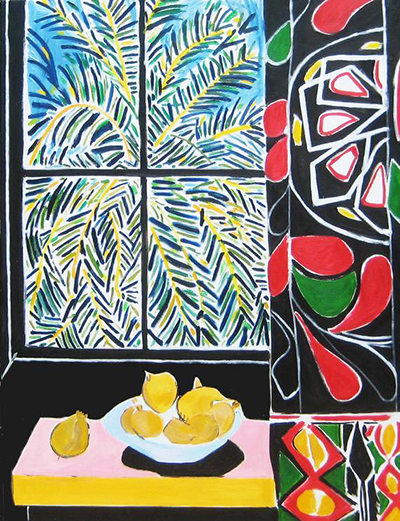Interior with Egyptian Curtain was completed by Matisse in 1948, by which point he had become comfortable working in the contemporary, abstract approach that dominated the latter period of his career.
Whilst not being the most famous painting from Matisse's oeuvre, it does still provide us with several key elements of his typical style. The colours, for starters, are bright and bold, with large blocks of colour decorating his relatively simple forms, where detail is not overly important. There is also the flattening of perspective to be seen here, similar to how a number of modern art movements, such as Cubism, would attempt to provide twists on reality that essentially created brand new worlds in which artists could play. Others who took on this approach to removing perspective almost entirely would include Georges Braque, someone who helped set up the original Cubist movement in conjunction with his friend and colleague, Pablo Picasso. Items such as Fruit on a Tablecloth with a Fruitdish and Balustre et Crane provide an idea of this in action.
There is a tinge of sadness with this artwork, however, in that Matisse would soon be incapable of constructing paintings in oils anymore and so would have to start looking for alternative options. That was where his cut-outs would then start to appear, where a new formula for work was developed which put less stress on his mind and body, but still allowed his creativity to show through. That then heralded in the likes of Icarus, Snail and Blue Nude. The style also matched with the earlier pieces such as Interior with Egyptian Curtain, where he was already moving away from large amounts of detail and focusing more on simple forms with minimal, but strong use of colour. Perhaps this style of painting would take longer in preparation than delivery, where Matisse would have planned the angle to paint within this room, as well as the assortment of items on the table. Once loose pencil strokes had provided outlines for these objects, the rest would surely have been fairly quick to put together.
This painting can be found in the The Phillips Collection, which is an art museum based in Washington, D.C., United States. Other notable pieces to be found here include Luncheon of the Boating Party by Renoir, as well as a number of artworks within the Rothko room, such as Green and Maroon, Green and Tangerine on Red and Orange and Red on Red. Islamic and North African culture has inspired many French artists over the past few centuries, in part influenced by the history of the French Empire as well as a general interest from western artists of travelling to other cultures in order to expand their own knowledge base and life experiences. Some exciting examples of this influence would be found in Women of Algiers by Eugene Delacroix and Prayer in the Mosque by Jean Leon Gerome.




